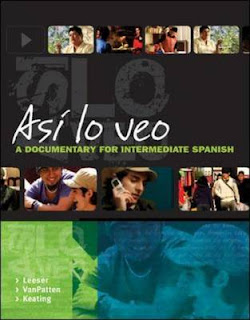Using Authentic Input: Tips from Michael Leeser and Greg Keating

by Ann Abbott
While at the ACTFL conference last week, I went to a workshop that Michael Leeser and Greg Keating gave about using authentic input in intermediate Spanish. Michael, Greg and Bill VanPatten are the authors of Así lo veo (McGraw-Hill), an intermediate textbook using unscripted documentary-style interviews with native speakers of Spanish. The book will be available in January 2010.
As Michael explained, some Spanish instructors claim that it is impossible to use authentic oral input with intermediate students because it is too hard for them to understand. Thus, the workshop centered on strategies for making authentic input accessible to students.
As I listened, my mind was also on the authentic, unscripted interviews with native speakers that are included with my own textbook, Comunidades: Más allá del aula. I'll post more about them in the future, with activities inspired by the information from Michael and Greg in their workshop.
I took lots of notes, and here I'll give you a list of tips that I jotted down.
Gregory D. Keating
- If you think the authentic language in the video is too fast for students to understand, try giving them a "scrambled sentence" to put together logically, before they view the video. That way, they will have read the sentence and worked with the content before they listen to it.
- Likewise, you can transcribe a fast or difficult passage and do a cloze activity in which students fill in the missing words, before or after they listen to it.
- When there are false starts in the video, ask students to focus on the facial gestures and body language that go along with them. They can give important clues about meaning.
- If the video includes regional slang, preview it and gloss it.
- If the video includes regional accents that might be unfamiliar to students and difficult for them to understand, you can start with a very short clip that highlights that particular feature and prepares students for it.
Michael Leeser
- You can use authentic input to teach grammar.
- Have students view clips once for what the speakers say, then have them re-view it to focus on how they say it.
- When students listen to various speakers, you can create an activity that gives quotes and asks students to identify who did say it or who would have been most likely to say it.
- Michael said, "It's not so much about the content per se, it's about the tasks we give students to do."
- One of Michael's students brought a video clip to class of Star War's R2-D2 "talking." His student asked, "Is R2-D2 happy or sad?" Even though no one could understand what he was saying, everyone could answer. That's a powerful example of how the proper task can really help students glean meaning from authentic input.
Discussion
- Authentic video is more than just listening comprehension. The visuals are also important input: body language, the physical environment, pragmatics, etc.
- Videos are good for homework to be done outside of class.
- A woman in the audience who teaches in Iowa mentioned that due to changing demographics in her state, many of her students actually work with native Spanish speakers in their part-time jobs. The authentic input with regionalisms is actually just what they need. She also mentioned that "relationship building" is what they're trying to accomplish right now. Very insightful and something to really think about...
- Michael said that he sometimes shows students a clip from a feature film with no sound, just action. He then asks them to write the script. He shows it again with the sound on, and they compare how closely their script matched the real one.
Congratulations to the authors for their great work



replica louis vuitton bags
ReplyDeleteare an important part of fashion, the type of louis vuitton replica bags
that a lady carries will affect the way her wardrobe looks, carrying cheap louis vuitton purses
made by popular designer labels has been very fashionable.